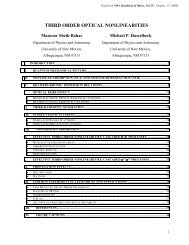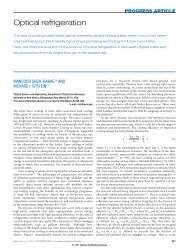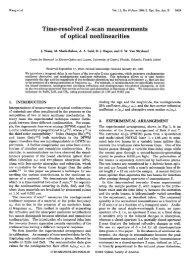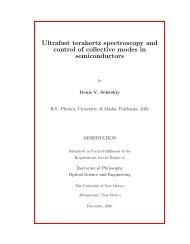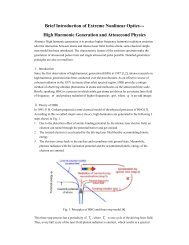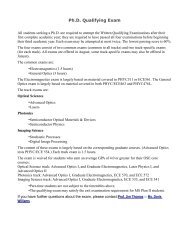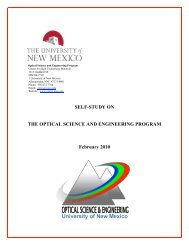Semiconductor Saturable Absorber Mirror (SESAM)
Semiconductor Saturable Absorber Mirror (SESAM)
Semiconductor Saturable Absorber Mirror (SESAM)
You also want an ePaper? Increase the reach of your titles
YUMPU automatically turns print PDFs into web optimized ePapers that Google loves.
Fig. 2(a) shows how does the saturable absorber work. A semiconductor absorbs light when the photon<br />
energy is sufficient to excite carriers from the valence band to the conduction band [2]. Under conditions<br />
of strong excitation, the absorption is saturated because possible initial states of the pump transition are<br />
depleted while the final states are partially occupied. Within 60~300 fs of excitation, the carriers in each<br />
band thermalize, and this leads to a partial recovery of the absorption. On a longer time scale, typically<br />
between a few picoseconds and a few nanoseconds—the carrier will be removed by recombination and<br />
trapping. The presence of two different time scales can be rather useful for modelocking. The longer time<br />
constant results in a reduced saturation intensity for a part of the absorption, which facilitates self-starting<br />
mode-locking, whereas the faster time constant is more effective in shaping subpicosecond pulses.<br />
Therefore, <strong>SESAM</strong>s allow us to easily obtain self-starting mode-locking [2].<br />
As the low intensity part of the pulse will be absorbed, while the high intensity part will pass the<br />
material with little loss, which result in the compression of the pulse, i.e. the pulse becomes shorter and<br />
shorter when it passes through this saturable absorber. And fig.2.b) shows the three fundamental passive<br />
mode-locking models. : i) passive mode-locking with a slow saturable absorber and dynamic gain<br />
saturation. ii) fast absorber mode-locking. iii) soliton mode-locking. These three basic models show us<br />
the different pulses we will get, combining of different gain medium and absorbers [1].<br />
2. Overview of Different <strong>SESAM</strong>s Designs and Parameters Control<br />
<strong>Semiconductor</strong> saturable absorbers have the advantage that the relevant absorber parameters can be varied<br />
by several orders of magnitude. Thus semiconductor saturable absorbers offer significant improvements<br />
in performance compared with other saturable absorber. Now let’s go through various designs of<br />
<strong>SESAM</strong>’s, which achieve many of the desired properties. Fig. 3 shows four typical designs in historical<br />
order.<br />
Fig.3. Different <strong>SESAM</strong> devices. (a) High-finesse A-FPSA. (b) Thin AR-coated <strong>SESAM</strong>. (c) Low-finesse A-FPSA. (d) D-SAM [1]<br />
Fig.3(a) shows the first intracavity <strong>SESAM</strong> device, which was the antiresonant Fabry-Perot saturable<br />
absorber (A-FPSA) [1]. It has a rather high top reflector. Thus it is called the high-finesse A-FPSA. The<br />
Fabry-Perot is typically formed by the lower semiconductor Bragg mirror and a dielectric top mirror, with<br />
a saturable absorber and possibly transparent spacer layers in between. The thickness of the total absorber<br />
and spacer layers are adjusted such that the Fabry-Perot is operated at antiresonance. Operation at<br />
antiresonance results in a device that is broad-band and has minimal group velocity dispersion. The top<br />
reflector of the A-FPSA is an adjustable parameter that determines the intensity entering the<br />
semiconductor saturable absorber and, therefore, the effective saturation intensity or absorber cross<br />
section of the device.<br />
2


